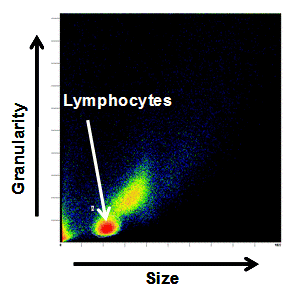Summary
Flow cytometers are versatile instruments that have been successfully used to enumerate cell subsets in infectious diseases (e.g., HIV) and to diagnose malignancies through changes in the expression levels of the cell receptors. Flow cytometer measurements are also used to support many clinical, pharmacologic, calibration, and measurement capability claims used for drug, device, and biologics product development and approval. At present, there is no commonly accepted method for quality control (QC) of the flow cytometer operation. Calibration and expression standards are not available for quantification of multiple disease biomarkers and enumeration of corresponding cell populations. We are working with other international standard organizations to test potential reference materials and measurement procedures to directly address these challenges.
Description

Internationally recognized and validated reference standards are currently not available in the field of cellular phenotyping by flow cytometry. The World Health Organization (WHO) has issued an open letter to the manufacturers of CD4+ T-cell enumeration technologies for the HIV/AIDS epidemic requesting that assays should be compatible with some form of external quality assessment. Lyophilized CD4+ cell counting standards, developed by our collaborators at NIBSC, UK, are suitable for both QA and performance monitoring and would ideally fill the WHO request. To fully standardize cellular phenotyping, fluorochrome conjugated reference antibodies for use with CD4+ cell counting are required. Cell standards need to be characterized in terms of absolute counts as well as the expression level and density of CD4+ on the cell surface. The selected fluorochrome-conjugated anti-CD4+ reference antibody needs to be characterized for CD4+ binding efficiency and fluorescence characteristics. Standardization of CD4+ cell enumeration would be a function of both cell and antibody standardization. The same approach could then be applied in a wider context to cellular phenotyping by flow cytometry.
Goals:
· Produce reference standards for phenotypic characterization and standardization of diagnostic testing by flow cytometry. These would be made available for QA and performance monitoring of CD4+ T cell enumeration as an internationally validated reference reagent. Specifically:
· Produce reference monoclonal antibody conjugates. The conjugates would be fully characterized to determine CD4 binding efficiency and absolute fluorescence. They would be made available as an internationally reference reagent for validation of fluorochrome conjugated anti-CD4 antibodies and for standardization of CD4+ T cell enumeration.
· Produce a fluorescently labeled reference cell standard. The cells would be fully characterized to determine CD4 binding capacity and absolute fluorescence of labeled CD4+ T cells.
· Develop a method for establishing a linearity scale for all fluorescence channels of a multicolor flow cytometer using polymer beads imbedded with different fluorochromes.
· Characterize the average CD4 antigen density on lyophilized cell surfaces. The reference fluorochrome conjugated anti-CD4 antibody could define the antigen density in terms of fluorescence. The total fluorescence of one labeled CD4+ cell will be defined in terms of molecules.

